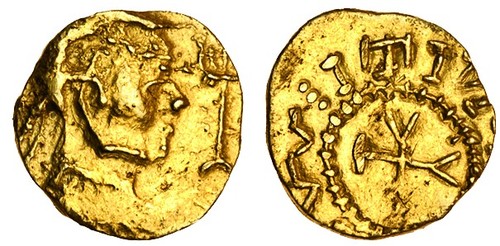
Auction: 14007 - Ancient, British and Foreign Coins and Commemorative Medals
Lot: 468
Anglo-Saxon, Crondall period, c.620-c.645, Thrymsas, 1.29g, Witmen 'hybrid' type, pearled and diademed bust right, trident with bifurcated base before rev. w:itm[...] around central cross with three terminals fourchée and one potent (Metcalf vol.1, 1-3, Pl. I, Nos 1-2; Sutherland type IV.ii, 58/9 (obverse 1a) / unlisted literate reverse die; c.f. SCBI 63 BM, No.11 prototype; N.25; S.753), reverse off-struck and with some light scuffing, otherwise as struck considering the state of the dilapidated obverse die, good very fine and excessively rare, this the only example of the recut Witmen 'prototype' die in private hands, the other three in the Ashmolean 'Crondall' collection, no example in the British Museum
provenance
Found Hatfield Broad Oak, Essex, 2014
Recorded with the Fitzwilliam Museum, Cambridge, EMC 2014.0249
The Witmen series of early thrymsas are traditionally known for their crude, naive style. This progressive degradation of style is typical of a series of dies which are repetitively copied over time. The prototype Witmen die, from which a single specimen is known, c.f. SCBI 63 British Museum, No. 11/Sutherland 57, is of typically Anglo-Saxon style but clearly based on a Roman model. It would appear that this already failing prototype die fell into unskilled hands and was recut for further use. From these new 'hybrid' dies just three specimens are known from the Crondall hoard (Sutherland Nos 69, 70, 71 and Plate III, Nos 21,22,23 respectively). The current piece, therefore, is believed to be only the fourth known specimen of the recut 'hybrid' dies, the first to appear since the Crondall find of 1828 (an impressive 176 years) and is believed to be the only specimen available to private buyers.
Subject to 20% VAT on Buyer’s Premium. For more information please view Terms and Conditions for Buyers.
Estimate
£3,500 to £5,500




